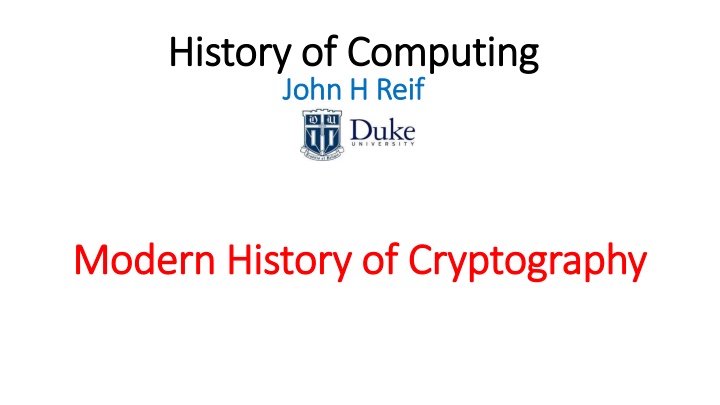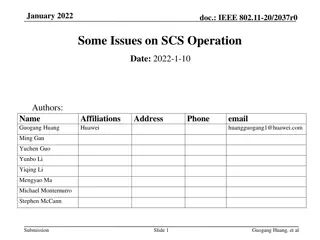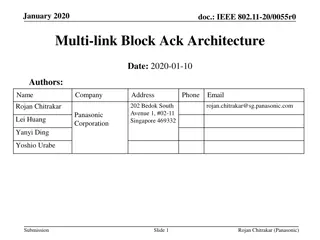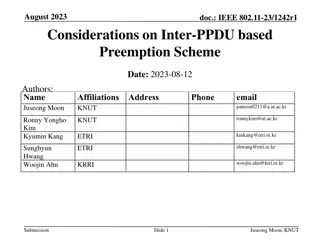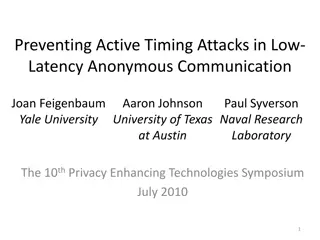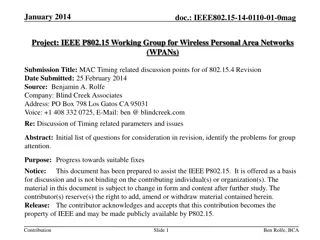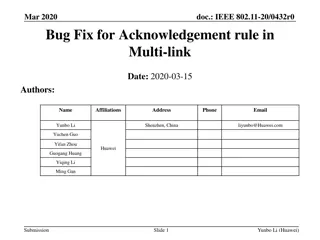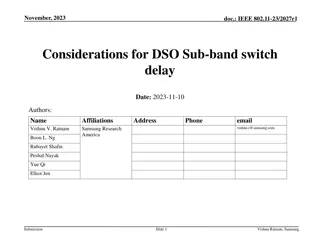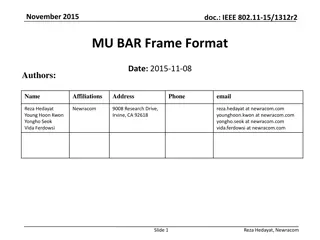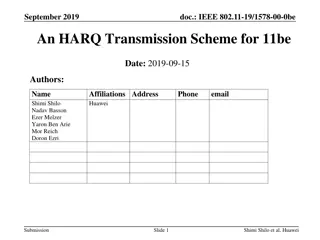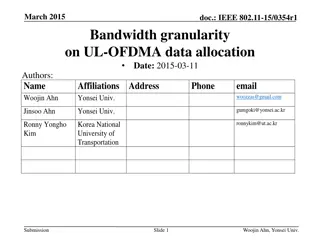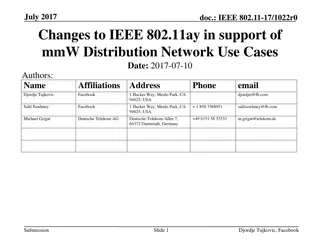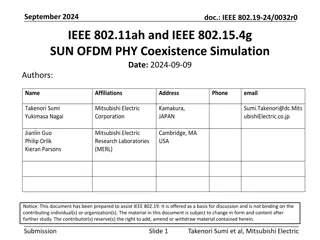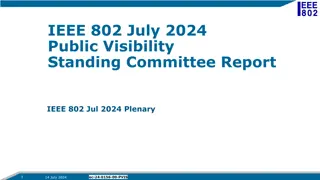Enhanced Ack Timing Issues in IEEE 802.15.4-2020 Standard
This document discusses the challenges with Enhanced Ack timing in the IEEE 802.15.4-2020 standard. Topics covered include Enhanced Ack usage, problem definition, and specific issues in the standard related to timing requirements and processing. Insights are provided by Khaled Ali from Synopsys.
Download Presentation

Please find below an Image/Link to download the presentation.
The content on the website is provided AS IS for your information and personal use only. It may not be sold, licensed, or shared on other websites without obtaining consent from the author.If you encounter any issues during the download, it is possible that the publisher has removed the file from their server.
You are allowed to download the files provided on this website for personal or commercial use, subject to the condition that they are used lawfully. All files are the property of their respective owners.
The content on the website is provided AS IS for your information and personal use only. It may not be sold, licensed, or shared on other websites without obtaining consent from the author.
E N D
Presentation Transcript
History of Computing History of Computing John H John H Reif Reif Modern History of Cryptography Modern History of Cryptography
History of Computing History of Computing Modern History of Cryptography Modern History of Cryptography Topics of this Lecture on Modern History of Cryptography: Symmetric-Key Encryption Data Encryption Standard (DES) Differential cryptanalysis of DES Possible trapdoor by NSA using shortened key Asymmetric-Key Encryption Diffie Hellman Key Exchange RSA Public Key Cryptography Authentication using Public Key Cryptography NSA attempts to keep avoid public disclosure of RSA. Secret Pre-History of Public Key Cryptography (sectigostore.com)
History of Computing History of Computing Modern History of Cryptography Modern History of Cryptography Symmetric-Key Encryption: the same key used for encryption and decryption. Data Encryption Standard (DES): a symmetric-key algorithm for the encryption of digital data. Developed by IBM in the 1970s. Was a Block cipher, which encoded fix-length blocks of plaintext using multiple rounds of processing. In 1976, adapted as a national standard by the US National Bureau of Standards (NBS). Was used by Banks and credit cards. Since 2001, DES has been withdrawn as a NBS national standard. Overall Structure of DES: 16 rounds of a Function (f), which permutes the bits. NSA (US National Security Agency) s Impact on DES design: NSA had substantial impact on DES design and adaption: Some suggestions, such as design of S-blocks, improved security, However, NSA requested the length of keys be lowered to 56 bits. The shorting of keys was later found to allow NSA to break DES using a brute-force attack with parallel hardware. Shortened keys can be considered a Trapdoor for NSA s ability to crack DES. Security of DES and its later versions: Methods for Attack: Brute-force Attack: Try all possible keys: takes 2n work for blocks of size n. Feasible for DES if using large amounts of parallel hardware. Even easier since Trapdoors were likely inserted into later versions of DES. Differential cryptanalysis: Determines how small differences in plaintext affects resulting ciphertext. Discovery and rediscovery: 1st discovered by NSA in the 1960s, rediscovered by researcher Coppersmith at IBM in the 1970s Further rediscovery and open publication by Israeli researcher Adi Shamir [1980s]
History of Computing History of Computing Modern History of Cryptography Modern History of Cryptography Public Key Cryptography: a cryptographic system that uses A pair of keys: A public key (which may be known to others), and A private key (known only by the owner). Key Generation: A random number is used to in the generation of a public key and private key for use by an asymmetric key algorithm. These asymmetric keys are used to determine for two easy-to- compute functions: An encryption function E that depends on the public key: Since it depends on the public key, E is known to everyone and easy-to-compute. Anyone can apply E to encode a message to the owner. Encryption and Decryption: Anyone can encrypt a message using a public key, Only the holder of the private key can decrypt resulting ciphertext. A decryption function D that depends on the private key: Since it depends on the private key, D only known by the owner. Only the owner can apply D to efficiently decode a message encoded by E.
History of Computing History of Computing Modern History of Cryptography Modern History of Cryptography Open History of Asymmetric-Key Cryptography: Diffie Hellman Key Exchange [1976]: by Whitfield Diffie & Martin Hellman Diffie, W.; Hellman, M.E. (November 1976). "New directions in cryptography". IEEE Transactions on Information Theory. 22 (6): 644 654. CiteSeerX 10.1.1.37.9720 . doi:10.1109/TIT.1976.1055638 Used exponentiation in a finite field 1st Open Publication of concept of public key cryptography Diffie Hellman Key Exchange: Each party generates a public/private key pair distributes the public key of the pair. Whitfield Diffie and Martin Hellman After obtaining a copy of each other's public keys: Alice and Bob can compute a shared secret offline. (sectigostore.com)
History of Computing History of Computing Modern History of Cryptography Modern History of Cryptography Open History of Asymmetric-Key Cryptography: RSA Public Key Cryptography [1978]: by Ron Rivest, Adi Shamir and Leonard Adleman The widest used method for public key cryptography. Rivest, R.; Shamir, A.; Adleman, L. (February 1978). "A Method for Obtaining Digital Signatures and Public-Key Cryptosystems" (PDF). Communications of the ACM. 21 (2): 120 126. doi:10.1145/359340.359342 NSA attempted to suppress publication of RSA: NSA tried to stop RSA s publication, but it was too late. The authors had already issued a Technical Report, which was distributed widely (100s of copies). Adi Shamir Ron Rivest, and Leonard Adleman (sectigostore.com) Later NSA successfully advocated a flawed formula for generating the random numbers used for RSA private keys: This allowed NSA to decrypt RSA encrypted messages. Eventually, this was discovered, and key generation was made more random.
History of Computing History of Computing Modern History of Cryptography Modern History of Cryptography Authentication: a cryptographic scheme where a document can be determined to have been written by a particular individual. Authentication using Public Key Cryptography: E is the encryption function D is the decryption function It is assumed that D(E(X)) = E(D(X)) for any message M. Authentication using Public Key Cryptography: In this example the message is digitally signed, but not encrypted. Alice signs a message with her private key. Bob can verify that Alice sent the message and that the message has not been modified. Given a document M The owner: Computes A = D(M), concatenate A to M to yield M . Anyone else can verify the owner constructed M from M by: Verifying that E(A)=E(D(M)) yields M.
History of Computing History of Computing Modern History of Cryptography Modern History of Cryptography James H. Ellis, Clifford Cocks, and Malcolm J. Williamson (sectigostore.com) Secret Pre-History of Public Key Cryptography Classified discoveries at UK Government Communications Headquarters (GCHQ): formerly classified Top Secret, but declassified in 1997 In 1970 James H. Ellis conceived of public key cryptography (he termed it "non-secret encryption") J H Ellis, The Possibility of Secure Non-Secret Digital Encryption, CESG Report 3006, January 1970 In 1973 Clifford Cocks invented a practical method of "non-secret encryption : essentially the RSA encryption algorithm C C Cocks, A Note on Non-Secret Encryption, CESG Report, 20 November 1973 in 1974 Malcolm J. Williamson invented the Diffie Hellman key exchange C C Cocks, A Note on Non-Secret Encryption, CESG Report, 20 November 1973 Original of TOP SECRET Report: J H Ellis, The Possibility of Secure Non-Secret Digital Encryption, CESG Report 3006, January 1970
